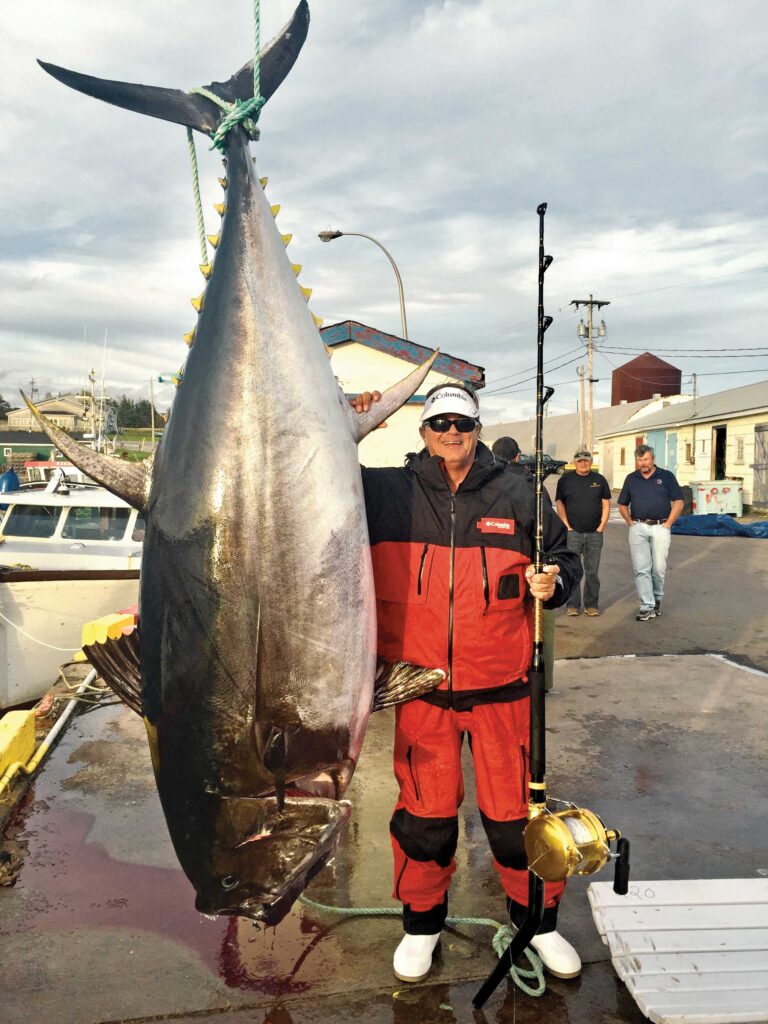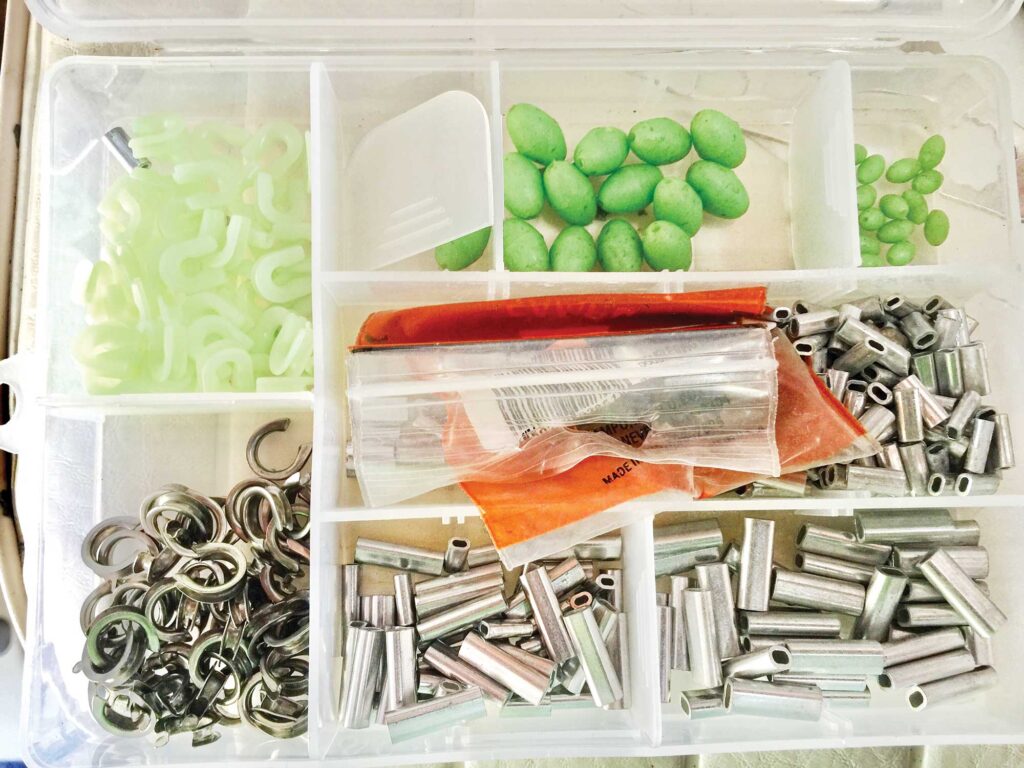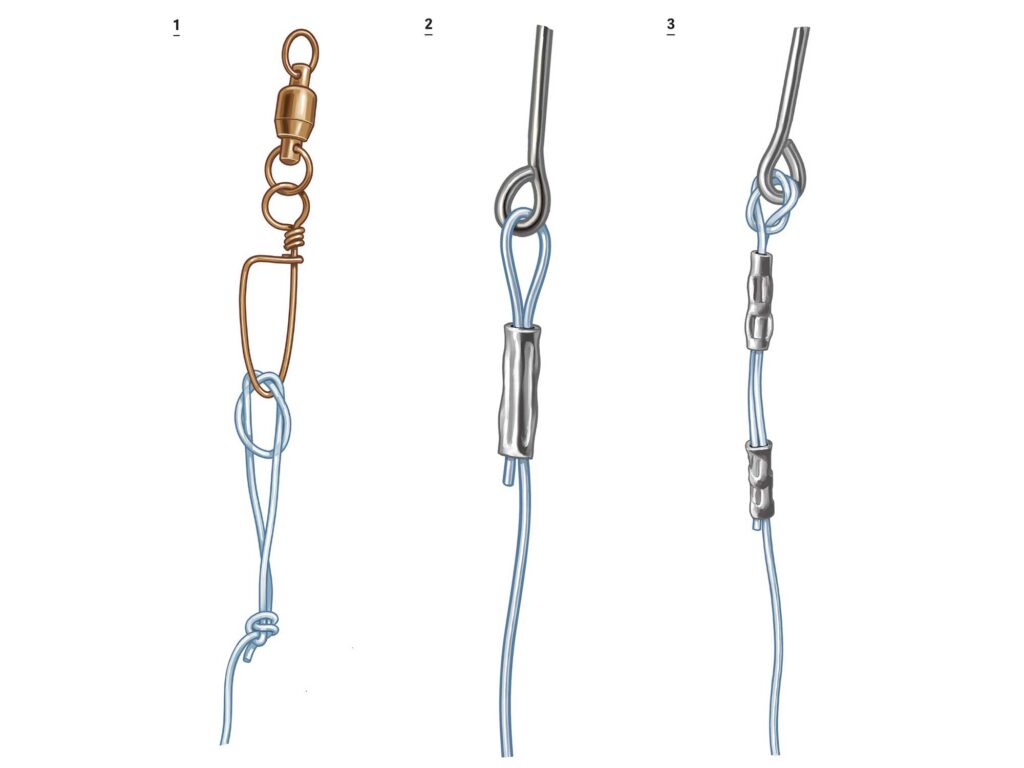
Successfully beating big fish requires total concentration, a smooth rhythm, and knowing when to apply more pressure—and back off. The least of one’s concerns should be a vulnerable leader-to-hook connection. Poorly tied knots, incorrect-size sleeves and inferior swaging contribute to the loss of many quality fish.
Whether to tie or crimp a leader to a hook or lure remains a long-standing dilemma. The basic answer hinges on the angler’s skill level and a leader’s breaking strength.
Mold Craft’s Frank Johnson III pretty much hit the nail on the head when he said: “Tying a knot is physical; crimping a connection is mechanical.” With decades of knot-tying and crimping experience from the thousands of Mold Craft lures sold by his company, he should know.
The Power of Knots
For my trolling efforts, I prefer tying fluorocarbon and monofilament leaders up to 130- and 150-pound-test. I’m confident in my knots, and doing so eliminates any concern over a crimped sleeve failing, mainly from undetected corrosion from time on the water.
In my home waters off southern Florida and the Bahamas, I believe sleeves on lighter leaders stand out more than knots. They could possibly draw the attention of barracudas and other toothy species while battling a quality gamefish. Yes, I’ve had a fight end because of such a cutoff before. It’s a heartbreaking feeling that can be prevented.
I prefer an overhand big-game loop knot with fluoro and mono leaders. The small loop provides more latitude for a presentation to perform fairly unrestricted. It also increases hook-setting success. This knot is for my general offshore trolling baits, live baits, bottom baits and casting lures.
For leaders over 150 pounds, it’s sleeves and swaging. This is pretty much the best way to work with and maintain the connection strength of heavy fluoro and mono leaders. Some offshore pros still prefer snelling hooks, but I prefer the less-restrictive and more proactive loop connection.
About Marlin Lures
For the longest time, the double-snelled hooks on Mold Craft marlin lures were the industry standard. However, evolution has taken over.
“Double hooks have fallen out of favor with blue marlin anglers,” Johnson says. “And rightly so, due to conservation. You want the best chances of survival for a released marlin, and a quick boatside release is paramount.”
Most of the professional marlin fishing teams are using a single-hook stiff rig, all crimped. “We rig our lures with what we call a ‘Twisty Rig,’” he says. “It’s a single, closed-bite-style tuna hook crimped to 300-pound-test mono with oval aluminum sleeves.”
As Johnson mentioned earlier, crimping is mechanical. “I can take a novice big-game troller and teach them how to properly sleeve and swage a lot faster than they’ll master offshore knots. A snell, overhand loop and others require practice and developing a feel. That comes over time, plus some folks have issues working with heavy leaders. Teaching them to crimp is a matter of educating them on the right sleeves and swaging process.”
Read Next: Easiest Line to Leader Knots

Don’t Pick Any Sleeve
Aluminum and brass are the two major crimp metals for saltwater fishing. Nickel, zinc and black oxide are plated finishes applied to brass sleeves. Aluminum and brass are less susceptible to pitting and corrosion. Plus, because of their softness, the two are less likely to damage a leader compared to stainless steel. Zinc-plated sleeves, incidentally, are recommended for cable leaders, as they prevent electrolysis from the dissimilar metals.
For lighter leaders, short, thin-walled, double-barrel sleeves are popular. Each leader strand lies independently of each other. It’s double protection against slippage. They’re low-profile, less noticeable, and shouldn’t interfere with the actions of smaller trolling lures, feathers and even natural baits. To lessen the risk of slippage, select the smallest-diameter sleeve that fits the respective leader. The leader should lie snug within the sleeve. To make this work, I sometimes trim the edge of a leader at an angle, for less of an entry profile. Once the leading edge passes through one barrel, the rest of the leader will follow. Ditto when it reenters the second chamber.
Oval, thick-walled sleeves are widely used for big-game fishing with heavy fluorocarbon and mono leaders. They’re highly recommended for fluorocarbon due to the roundness of that leader material.
Correctly swaged, single-sleeve connections are perfectly fine. However, for that extra bit of security, double-sleeve the connections. Most of my big-game lures and baits the likes of mackerel, mullet and horse ballyhoo are single-sleeved. When traveling to areas where large marlin are a definite possibility, I’ll double-sleeve. It’s cheap insurance against a crimp failure. What’s more, double-sleeving can also put space between a hook eye and lure head for fine-tuning hook placements.
Quality hand-crimping tools accommodate oval and double-barrel sleeves up to 200-pound-test. Heavier leaders are best suited for a bench swage. Avoid crimping the edges of a sleeve; this might crush the metal into the leader. Instead, crimp just the inside of a sleeve’s bitter edge. Done correctly, the outer sleeve should flare upward. Longer sleeves, recommended for heavier big-game leaders, will require one or two additional compressions.
Give It a Test
Crimping requires numerous components. However, Johnson swears it’s easy to master and the safest for big-game connections.
“I’ll crimp with leaders as light as 80-pound-test,” says Johnson. “And there are some freshwater guys who even crimp with 20-pound. It comes down to testing and finding the best unions of sleeves, leaders and hooks that excel for what you’re after. I’ve tested combinations 10 times before bringing them to sea. If breakage doesn’t occur at the sleeves, stick with that combination.”
Rick Mola, owner of Fisherman’s World in Norwalk, Connecticut, tests every crimped system before it leaves his store. He accomplishes this by attaching the connection to a screw affixed to a desk and applying heavy pressure. Mola is an accomplished New England offshore pro, and his shop caters heavily to the canyon and tuna fraternity. For him, there can never be a terminal-tackle failure.
Personal Preference Wins Out
Whether to knot or crimp comes down to leader strength, an angler’s skill level, and what they are accustomed to doing. Again, I’ll knot on just about everything up to 150 pounds. Then it’s single and often double sleeves. As far as frequently trolled lures, I’ll thoroughly wash, rinse and air-dry them in a nonsalt environment after each outing. Then, with a reel-oil-dampened washcloth, I’ll wipe down the sleeves. Prior to their next use, the sleeves get a close look for any signs of corrosion. There’s no excuse for a lost fish due to tackle failure.

1. Use the overhand big-game loop knot for creating a loop in leaders 150 pounds or lighter, to which a trolling swivel can attach.
2. A single crimp works well with lures and baits on standard trolling tackle for species such as white marlin, sailfish and mahi. Tip: Add a chafe guard to prevent wear against the hook eye.
3. The overhand big-game loop crimp connection is meant for trolling large lures and baits, especially with leaders 150 pounds and up. The extra loop wrap at the hook eye, plus a second crimp, provides additional safeguards.









